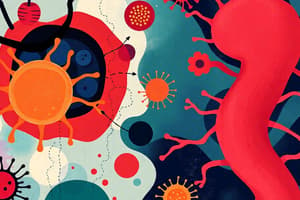Podcast
Questions and Answers
What is an infection?
What is an infection?
Infection is the invasion and multiplication of microorganisms in or on body tissue that produce signs and symptoms along with an immune response.
Which of the following are classic signs and symptoms of inflammation? (Select all that apply)
Which of the following are classic signs and symptoms of inflammation? (Select all that apply)
- Fever (correct)
- Swelling (correct)
- Loss of appetite
- Redness (correct)
Which of the following types of microorganisms are responsible for infectious diseases? (Select all that apply)
Which of the following types of microorganisms are responsible for infectious diseases? (Select all that apply)
- Viruses (correct)
- Cars
- Bacteria (correct)
- Fungi (correct)
What are the two classifications of bacteria based on shape?
What are the two classifications of bacteria based on shape?
The first true antibiotic was discovered by _____.
The first true antibiotic was discovered by _____.
Antimicrobial agents are the same as antibiotics.
Antimicrobial agents are the same as antibiotics.
Match the following antibiotics with their mechanism of action:
Match the following antibiotics with their mechanism of action:
What is the main difference between bactericidal and bacteriostatic antibiotics?
What is the main difference between bactericidal and bacteriostatic antibiotics?
Which of the following is an example of a broad-spectrum antibiotic?
Which of the following is an example of a broad-spectrum antibiotic?
Flashcards are hidden until you start studying
Study Notes
Infection Overview
- Infection involves the invasion and multiplication of microorganisms in body tissues, leading to signs, symptoms, and immune responses.
- Cellular damage can result from toxins produced by microorganisms or their metabolic competition with the host.
- Severity of infection is influenced by microbial characteristics, microorganism count, and entry/spread mechanisms.
- Vulnerability is higher among the very young and very old.
Inflammatory Response
- The body reacts to microbial invasion through inflammation, characterized by:
- Redness: Increased blood flow due to dilated arterioles.
- Pain: Stimulation of pain receptors due to tissue swelling.
- Heat: Local vasodilation and increased blood flow.
- Swelling: Fluid leakage into interstitial spaces.
- Loss of function: Resulting from pain and edema.
- Additional symptoms can include fever, malaise, nausea, vomiting, and purulent discharge.
Types of Infectious Agents
- Infectious diseases can be caused by various microorganisms:
- Bacteria: Classified as Gram-positive, Gram-negative, or acid-fast.
- Viruses: Include DNA and RNA viruses.
- Fungi: Encompasses yeasts and molds.
- Parasites: Consists of protozoa and helminths.
Bacterial Infections
- Bacteria are classified by:
- Shape: Cocci (spherical), bacilli (rod-shaped), spirilla (spiral).
- Gram Staining: Determines whether bacteria are Gram-positive or Gram-negative.
- Oxygen Consumption: Aerobic or anaerobic.
- Motility: Motile or nonmotile.
- Encapsulation: Encapsulated or nonencapsulated.
- Spore Formation: Sporulating or nonsporulating.
Antibiotics and Antimicrobials
- Antibiotics: Chemicals produced by microorganisms that kill or inhibit the growth of other microorganisms.
- Antimicrobial Agents: Chemical substances that kill or inhibit microorganisms, including non-antibiotics.
Antibiotic Classification
-
Based on Mode of Action:
- Bactericidal: Target cell wall or membrane, leading to cell death (e.g., penicillins, cephalosporins).
- Bacteriostatic: Inhibits protein synthesis (e.g., macrolides, tetracyclines).
-
Based on Spectrum of Activity:
- Narrow Spectrum: Effective against specific bacteria (e.g., Penicillin G).
- Broad Spectrum: Effective against a wide range (e.g., Amoxicillin/Clavulanic acid).
- Extended Spectrum: Enhanced activity against additional bacteria (e.g., Piperacillin, Ticarcillin).
- High Extended Spectrum: Very broad activity (e.g., Piperacillin/Tazobactam).
Key Antibiotic Classes
- Cell Wall Synthesis Inhibitors: Penicillins, cephalosporins, carbapenems.
- Nucleic Acid Synthesis Inhibitors: Quinolones, rifamycins.
- Folate Synthesis Inhibitors: Sulphonamides, Trimethoprim.
- Protein Synthesis Inhibitors: Aminoglycosides, tetracyclines, macrolides.
Important Notes
- The effectiveness of no antibiotic is universally guaranteed; antibiotic resistance can reduce effectiveness against specific bacteria.
Studying That Suits You
Use AI to generate personalized quizzes and flashcards to suit your learning preferences.




